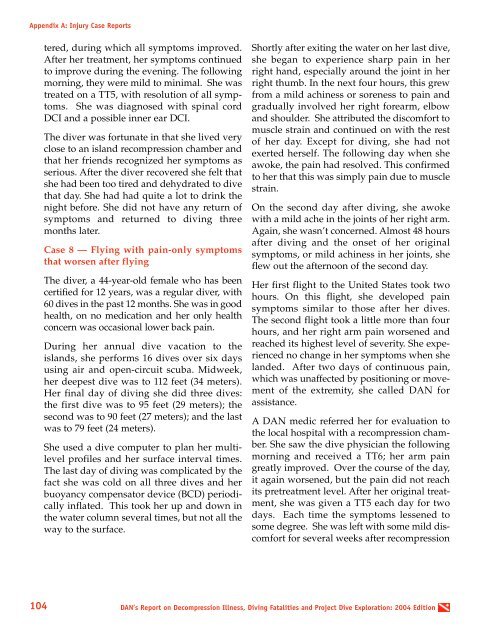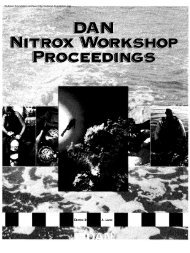Report on Decompression Illness, Diving Fatalities and Project Dive
Report on Decompression Illness, Diving Fatalities and Project Dive
Report on Decompression Illness, Diving Fatalities and Project Dive
- No tags were found...
Create successful ePaper yourself
Turn your PDF publications into a flip-book with our unique Google optimized e-Paper software.
Appendix A: Injury Case <str<strong>on</strong>g>Report</str<strong>on</strong>g>stered, during which all symptoms improved.After her treatment, her symptoms c<strong>on</strong>tinuedto improve during the evening. The followingmorning, they were mild to minimal. She wastreated <strong>on</strong> a TT5, with resoluti<strong>on</strong> of all symptoms.She was diagnosed with spinal cordDCI <strong>and</strong> a possible inner ear DCI.The diver was fortunate in that she lived veryclose to an isl<strong>and</strong> recompressi<strong>on</strong> chamber <strong>and</strong>that her friends recognized her symptoms asserious. After the diver recovered she felt thatshe had been too tired <strong>and</strong> dehydrated to divethat day. She had had quite a lot to drink thenight before. She did not have any return ofsymptoms <strong>and</strong> returned to diving thre em<strong>on</strong>ths later.Case 8 — Flying with pain-<strong>on</strong>ly symptomsthat worsen after flyingThe diver, a 44-year-old female who has beencertified for 12 years, was a regular diver, with60 dives in the past 12 m<strong>on</strong>ths. She was in goodhealth, <strong>on</strong> no medicati<strong>on</strong> <strong>and</strong> her <strong>on</strong>ly healthc<strong>on</strong>cern was occasi<strong>on</strong>al lower back pain.During her annual dive vacati<strong>on</strong> to theisl<strong>and</strong>s, she performs 16 dives over six daysusing air <strong>and</strong> open-circuit scuba. Midweek,her deepest dive was to 112 feet (34 meters).Her final day of diving she did three dives:the first dive was to 95 feet (29 meters); thesec<strong>on</strong>d was to 90 feet (27 meters); <strong>and</strong> the lastwas to 79 feet (24 meters).She used a dive computer to plan her multilevelprofiles <strong>and</strong> her surface interval times.The last day of diving was complicated by thefact she was cold <strong>on</strong> all three dives <strong>and</strong> herbuoyancy compensator device (BCD) periodicallyinflated. This took her up <strong>and</strong> down inthe water column several times, but not all theway to the surface.Shortly after exiting the water <strong>on</strong> her last dive,she began to experience sharp pain in herright h<strong>and</strong>, especially around the joint in herright thumb. In the next four hours, this grewfrom a mild achiness or soreness to pain <strong>and</strong>gradually involved her right forearm, elbow<strong>and</strong> shoulder. She attributed the discomfort tomuscle strain <strong>and</strong> c<strong>on</strong>tinued <strong>on</strong> with the restof her day. Except for diving, she had notexerted herself. The following day when sheawoke, the pain had resolved. This c<strong>on</strong>firmedto her that this was simply pain due to musclestrain.On the sec<strong>on</strong>d day after diving, she awokewith a mild ache in the joints of her right arm.Again, she wasn’t c<strong>on</strong>cerned. Almost 48 hoursafter diving <strong>and</strong> the <strong>on</strong>set of her originalsymptoms, or mild achiness in her joints, sheflew out the afterno<strong>on</strong> of the sec<strong>on</strong>d day.Her first flight to the United States took twohours. On this flight, she developed painsymptoms similar to those after her dives.The sec<strong>on</strong>d flight took a little more than fourhours, <strong>and</strong> her right arm pain worsened <strong>and</strong>reached its highest level of severity. She experiencedno change in her symptoms when shel<strong>and</strong>ed. After two days of c<strong>on</strong>tinuous pain,which was unaffected by positi<strong>on</strong>ing or movementof the extremity, she called DAN forassistance.A DAN medic referred her for evaluati<strong>on</strong> tothe local hospital with a recompressi<strong>on</strong> chamber.She saw the dive physician the followingmorning <strong>and</strong> received a TT6; her arm paingreatly improved. Over the course of the day,it again worsened, but the pain did not reachits pretreatment level. After her original treatment,she was given a TT5 each day for twodays. Each time the symptoms lessened tosome degree. She was left with some mild discomfortfor several weeks after recompressi<strong>on</strong>104DAN’s <str<strong>on</strong>g>Report</str<strong>on</strong>g> <strong>on</strong> Decompressi<strong>on</strong> <strong>Illness</strong>, <strong>Diving</strong> <strong>Fatalities</strong> <strong>and</strong> <strong>Project</strong> <strong>Dive</strong> Explorati<strong>on</strong>: 2004 Editi<strong>on</strong>
















